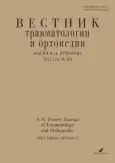Problems with fixing chronic injuries of the anterior pelvic ring
- Authors: Lazarev A.F.1, Solod E.I.1, Gudushauri Y.G.1, Kakabadze M.G.1, Roskidailo A.S.1, Kalinin E.I.1, Konovalov V.V.1, Marychev I.N.1
-
Affiliations:
- N.N. Priorov National Medical Research Center of Traumatology and Orthopedics
- Issue: Vol 28, No 3 (2021)
- Pages: 5-12
- Section: Original study articles
- URL: https://bakhtiniada.ru/0869-8678/article/view/89514
- DOI: https://doi.org/10.17816/vto89514
- ID: 89514
Cite item
Full Text
Abstract
BACKGROUND: A separate problem is the surgical treatment of the pelvic joints, especially the pubic joint. Stabilization in the case of chronic pelvic injuries using standard methods used in the treatment of patients with acute pelvic injuries reveals cases of plate fatigue fractures, metal structures migrations and the need for repeated surgical interventions. In this regard, in order to fix injuries to the anterior pelvis in case of chronic injuries, it is necessary to use other, special tactical approaches to fixing bone fractures and joint ruptures, and to develop metal structures adapted for such cases.
AIM: To study of the features of fixation in chronic pelvic injuries and analysis of the results with various methods of fixation of the anterior pelvic ring in chronic cases.
MATERIALS AND METHODS: Under our supervision in the first department of the “FGBU NMITs TO im. NN Priorov” of the Ministry of Health of the Russian Federation for the period from 2000 to 2015. 117 patients were observed who underwent surgical treatment using standard reconstructive plates for chronic injuries of the anterior pelvis used in the surgical treatment of acute injuries of the pelvic ring.
RESULTS: Group No. 1, consisting of 65 patients who underwent fixation of the anterior half-ring with reconstructive plates, implanted in the standard way as in acute trauma, 12 patients (10.2%) had migration or fracture of metal structures for a period of 2 to 6 months from the date of surgery.
Group No. 2 consists of 52 patients who underwent fixation of the anterior pelvic semicircle with two plates located on the pubic bones mutually perpendicular to each other using the standard method. Destabilization of metal structures was detected in 7 patients (13.4%) with X-ray control in the period from 2 weeks to 2 months after the operation.
CONCLUSION: The standard approach to fixation of such injuries, as in acute (up to 3 weeks from the moment of injury), does not create conditions for stable fixation. In the first case, attention is drawn to the fact that after the plate fracture, the diastasis between the pubic bones increased to almost the same level as at the time of admission. From this, it can be concluded that the fibro-cicatricle process formed in traumatic foci creates a rigid deformation, and when restoring the anatomical integrity of the pelvic ring, with the use of bone osteosynthesis, the plate with chronic injuries experiences stronger loads than in acute trauma and causes a fatigue fracture of metal structures.
Full Text
##article.viewOnOriginalSite##About the authors
Anatoly F. Lazarev
N.N. Priorov National Medical Research Center of Traumatology and Orthopedics
Email: lazarev.anatoly@gmail.com
MD, PhD, Dr. Sci. (Med.), traumatologist-orthopedist
Russian Federation, 127299, Moscow, st. Priorova 10Edward I. Solod
N.N. Priorov National Medical Research Center of Traumatology and Orthopedics
Email: doctorsolod@mail.ru
MD, PhD, Dr. Sci. (Med.), traumatologist-orthopedist
Russian Federation, 127299, Moscow, st. Priorova 10Yago G. Gudushauri
N.N. Priorov National Medical Research Center of Traumatology and Orthopedics
Email: gogich71@mail.ru
MD, PhD, Dr. Sci. (Med.); traumatologist-orthopedist
Russian Federation, 127299, Moscow, st. Priorova 10Malkhaz G. Kakabadze
N.N. Priorov National Medical Research Center of Traumatology and Orthopedics
Email: malkhaz@mail.ru
MD, PhD, Cand. Sci. (Med.), traumatologist-orthopedist
Russian Federation, 127299, Moscow, st. Priorova 10Alexander S. Roskidailo
N.N. Priorov National Medical Research Center of Traumatology and Orthopedics
Email: al-sergeevich@mail.ru
MD, PhD, Cand. Sci. (Med.), traumatologist-orthopedist
Russian Federation, 127299, Moscow, st. Priorova 10Evgene I. Kalinin
N.N. Priorov National Medical Research Center of Traumatology and Orthopedics
Author for correspondence.
Email: Kalinin_evgeny@mail.ru
ORCID iD: 0000-0003-2766-5670
MD, post-graduate student, traumatologist-orthopedist
Russian Federation, 127299, Moscow, st. Priorova 10Vyacheslav V. Konovalov
N.N. Priorov National Medical Research Center of Traumatology and Orthopedics
Email: slava2801@yandex.ru
ORCID iD: 0000-0002-8954-9192
medical resident
Russian Federation, 127299, Moscow, st. Priorova 10Ivan N. Marychev
N.N. Priorov National Medical Research Center of Traumatology and Orthopedics
Email: dr.ivan.marychev@mail.ru
ORCID iD: 0000-0002-5268-4972
medical resident
Russian Federation, 127299, Moscow, st. Priorova 10References
- Ruedi TP, Buckley RE, Morgan CG. AO principles of fracture management. 2nd ed. Switzerland: AO Publishing; 2007. P. 696–717.
- Simon RR, Sherman SC, Koenigsknecht SJ. Emergency orthopedics: the extremities. 5th ed. New York: McGraw-Hill; 2007. P. 361–391.
- Tile M. Acute pelvic fractures: I. Causation and classification. J Am Acad Orthop Surg. 1996;4(3):143–151. doi: 10.5435/00124635-199605000-00004
- Dyatlov MM. Complex injuries to the pelvis. What to do? Guide for doctors and students. Gomel: Gomel State Medical University; 2006. 496 p.
- Tornetta P, Matta JM. Internal fixation of unstable pelvic ring injuries. Orthop Trans. 1994;18(4):727–733.
- Lazarev AF, Gudushauri YG, Kostiv EP, et al. Challenging issues of the doctrine of the pelvis polytrauma. Pacific Medical Journal. 2017;(1):17–23. doi: 10.17238/PmJ1609-1175.2017.1.17-23
- Stelmakh KK. Treatment of unstable pelvic injuries. Traumato-logy and Orthopedics of Russia. 2005;(4):31–38.
- Shlykov IL. Variants of surgical techniques depending on the type of pelvic deformity. Perm Medical Journal. 2009; 26(6):50–53.
- Ivanov PA, Zadneprovskiy NN. Efficacy of various arrangements of pelvic external rod fixators in polytraumatized patients at resuscitation step. N.N. Priorov Journal of Traumatology and Orthopedics. 2014;21(1):12–18. doi: 10.17816/vto20140112-18
- Ushakov SA, Lukin SY, Nikol’skiy AV. Treatment of vertically unstable pelvic ring injuries in patients with complicated pelvic trauma. N.N. Priorov Journal of Traumatology and Orthopedics. 2014;21(1):26–31. doi: 10.17816/vto20140126-31
- Donchenko SV, Dubrov VE, Golubyatnikov AV, et al. Techniques for final pelvic ring fixation based on the method of finite element modeling. N.N. Priorov Journal of Traumatology and Orthopedics. 2014;21(1):38–44. doi: 10.17816/vto20140138-44
- Majeed SA. Grading the outcome of pelvic fractures. J Bone Joint Surg. 1989;71(2):304–306. doi: 10.1302/0301-620X.71B2.2925751
Supplementary files















